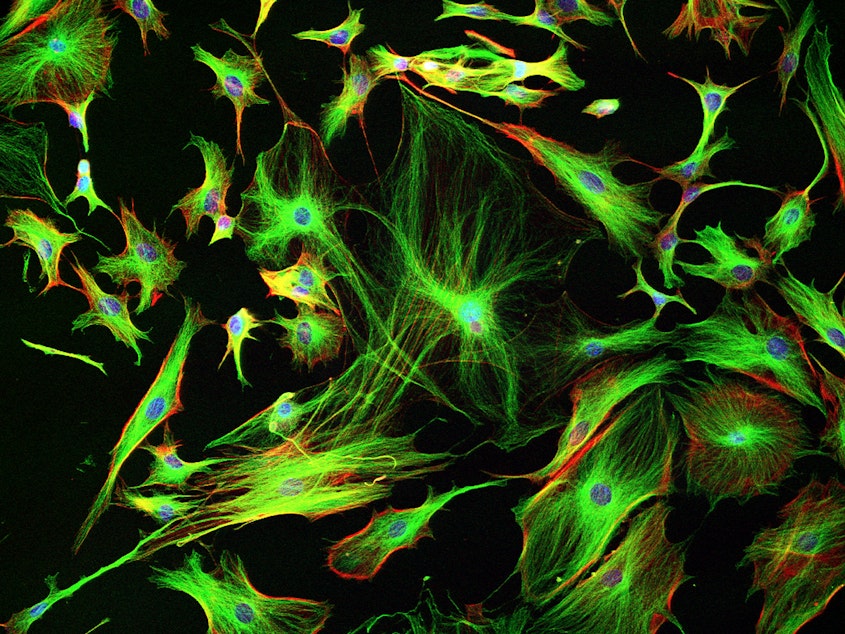Subtle Differences In Brain Cells Hint at Why Many Drugs Help Mice But Not People

In mice, scientists have used a variety of drugs to treat brain disorders including murine versions of Alzheimer's disease, depression and schizophrenia. But in people, these same treatments usually fail.
And now researchers are beginning to understand why.
A detailed comparison of the cell types in mouse and human brain tissue found subtle but important differences that could affect the response to many drugs, a team reports Wednesday in the journal Nature.
"If you want to develop a drug that targets a specific receptor in a specific disease, then these differences really matter," says Christof Koch, an author of the study and chief scientist and president of the Allen Institute for Brain Science in Seattle.
One key difference involved genes that cause a cell to respond to the chemical messenger serotonin, says Ed Lein, a study author and investigator at the institute.
Sponsored
"They're expressed in both mouse and human, but they're not in the same types of cells," Lein says. As a result, "serotonin would have a very different function when released into the cortex of the two species."
That's potentially a big deal because antidepressants like Prozac act on the brain's serotonin system. So testing these drugs on mice could be misleading, Lein says.
The comparison was possible because of new technology that allows scientists to quickly identify which of the hundreds of types of brain cells are present in a particular bit of brain tissue.
The technology does this by detecting which genes are switched on in each cell. That reveals a genetic signature indicating the type of cell.
"In one fell swoop you can get a more or less comprehensive understanding of all of the different types of cells that make up a brain region," Lein says.
Sponsored
This also makes it much easier to compare brain tissue from different species, he says.
"We now have access to this fine level of resolution in the human brain and the ability to compare across and see how good a model a mouse or a monkey actually is," Lein says.
The list of cell types also should help researchers see what goes wrong in human brain disorders, Koch says.
"A lot of neurological diseases, a lot of psychiatric diseases that we're suffering from are due to specific defects in particular types of cells," Koch says.
For example, Parkinson's disease affects brain cells that make a substance called dopamine. And epilepsy involves special cells that tamp down brain activity.
Sponsored
Now, researchers have a way to make sure the types of cells involved in a particular disease work the same way in people as in an animal model, Koch says.
"The technology finally caught up with what we've been needing to do for probably over 40 years," says Tomasz Nowakowski, an assistant professor of anatomy at the University of California, San Francisco who co-wrote an editorial that accompanied the study.
To compare mouse and human brain cells, researchers first analyzed sixteen thousand human brain cells taken from the middle temporal gyrus, a part of the cortex, the brain's outermost layer. Then they looked at cells taken from the same area of a mouse brain.
"In one sense, they are remarkable similar," Koch says, noting that both mice and people had about 100 different types of cells in this region of the brain.
But a close comparison of 75 of these brain cell types revealed small differences.
Sponsored
Nowakowsky is especially intrigued by the finding that cells called microglia have a slightly different genetic signature in mice and people.
"Those cells are the immune cells of the brain," he says. "And you might imagine that studies or insights into neuroimmune disorders, for example, might be vastly affected by this difference."
Neuroimmune disorders include multiple sclerosis, systemic lupus, and amyotrophic lateral sclerosis. But there's growing evidence that microglia also play an important role in Alzheimer's disease.
And that could be one reason experimental Alzheimer's drugs have helped mice, but not people. [Copyright 2019 NPR]



